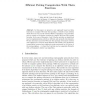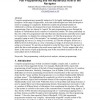481 search results - page 4 / 97 » The benefits of pairing by ability |
131
Voted
ANTS
2010
Springer
15 years 4 months ago
2010
Springer
In this paper, we present a new approach based on theta functions to compute Weil and Tate pairings. A benefit of our method, which does not rely on the classical Miller's alg...
100
click to vote
CHI
2006
ACM
16 years 1 months ago
2006
ACM
When pairs work together on a physical task, seeing a common workspace benefits their performance and transforms their use of language. Previous results have demonstrated that vis...
110
Voted
AAECC
2005
Springer
15 years 18 days ago
2005
Springer
Abstract In [24], a new size-change principle was proposed to verify termination of functional programs automatically. We extend this principle in order to prove termination and in...
111
click to vote
IJMMS
2008
15 years 20 days ago
2008
Computer programming is generally understood to be highly challenging and since its inception a wide range of approaches, tools and methodologies have been developed to assist in ...
91
Voted
PERCOM
2009
ACM
16 years 1 months ago
2009
ACM
Abstract--"Secure Device Pairing" is the process of bootstrapping a secure channel between two previously unassociated devices over a (usually wireless) human-imperceptib...


